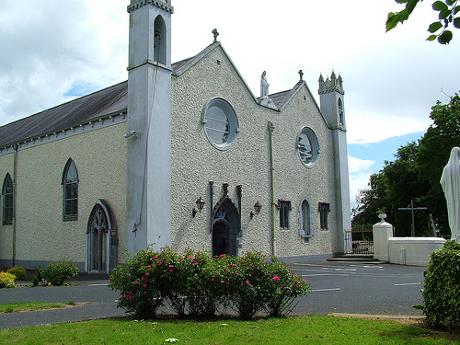of Ballyhaunis
HISTORY
& BACKGROUND
The town of Ballyhaunis itself grew around the
original Augustinian settlement of St. Mary’s Abbey which was founded in the
14th Century (circa 1348) and has played a major role in the town’s development
and the welfare of its people over the centuries.
The Augustinians maintained a presence in the town
until 2001 when they made their decision to withdraw from Ballyhaunis. As part of this process of withdrawal, the
Augustinians sought proposals from all in the community on the future use of
the Friary house, St. Mary’s Abbey and the surrounding lands.
At the Ceremony marking the withdrawal of the
Augustinian Order from St. Mary's Abbey, which took place on Sunday 16th June
2001 and was highlighted by the Chief Celebrant at the Mass - Fr. Desmond
Foley, O.S.A., Provincial of the Augustinian Order in his address at the final
ceremony, referring to the great sadness which prevailed amongst all those
present. He said that the Augustinian Order had hit bad times, referring to the
steady decline in their numbers, and the fall-off in vocations to the order. He
prayed for "the healing of any hurts that have been caused by our
departure both to local people and to Augustinians", and added: "These buildings - this holy place made
holy by prayer - will remain at the service of the local community.
The land around us will be a place where, we hope;
people will find peace and find God. These amenities and the graves of the
friars who died here will be a perpetual memorial to the Augustinians of
Ballyhaunis."
In the homily delivered by Fr. Dick Lyng O.S.A., who
resides in their Galway house, outlined the long history of the Augustinian
presence in Ballyhaunis and of the many friars who have served here since the
fourteenth century.
He traced the origins of the Augustinian Order in
Ireland back to their arrival with their Anglo-Norman overlords and patrons in
the twelfth century. Highlighting that
they became 'more Irish than the Irish themselves', he explained that they cut
away from their English origins and influences, departed from the towns and
sought-out more sparsely populated places to build their abbeys.
Their first house in the West was at Ballinrobe, and
from here they spread to Ardnaree (Ballina), Burriscarra, Banada, Dunmore and
Ballyhaunis.
Fr. Lyng made reference to one Fr. Hugh O'Malley, a
Ballyhaunis born Augustinian who, in February 1547, negotiated with Rome and
secured a certain degree of independence for the Augustinians in the province
of Connacht.
Another contributor was Fr. Aidan O'Leary O.S.A. who explained
that "We are aware that today is a
day of great sadness; it is a day of great disappointment in the long, long
history of St. Mary's Abbey here in Ballyhaunis, because, as we know, after
more than six hundred years, today is the final day of the presence of the
Augustinians in this holy, sacred and historical site. Nobody thought that
they'd experience what is going to happen today and there are lots of emotions
such as sadness and disappointment shared not just by the people of Ballyhaunis
but surrounding areas too, because they are the people for whom the Abbey is,
and always has been part of their very souls. Those emotions are shared too by
many, many Irish Augustinians.
THE
ABBEY PARTNERSHIP
As mentioned earlier, the Augustinians sought
proposals from all in the community on the future use of the grounds and a
number of written submissions and proposals were received from local groups,
whom the Augustinians then brought together and asked to establish a local
company to hold in trust and manage their property in Ballyhaunis.
Arising from this, two organisations were
established - the Ballyhaunis Abbey Trust and the Ballyhaunis Abbey
Partnership. The first organisation – the Ballyhaunis Abbey Trust, is composed
of representatives from the Ballyhaunis Community Council, Mayo County Council
and nominees of the Augustinians themselves.
The second organisation is the Ballyhaunis Abbey
Partnership, was established to manage and develop the overall property on
behalf of the Trust on a day-to-day basis.
PURPOSE
OF THE ABBEY PARTNERSHIP:
2010 was a productive year for the Ballyhaunis Abbey
Partnership and Abbey Trust, building on the work carried out over the last
years since the withdrawal of the Augustinian friars.
The Ballyhaunis Abbey Partnership was established in
June 2002 following the decision of the Irish Province of the Augustinian Order
to commit the Augustinian Abbey and property in Ballyhaunis, for the benefit of
the people after their decision to withdraw from the town in 2001.
The Abbey Partnership has sought to maintain and
develop the overall Augustinian property, ensuring that it remains a major
social amenity for the people and families of Ballyhaunis and surrounding
areas.
